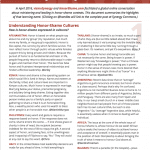What’s the distinction between evangelism and an elevator pitch? If you look at how we actually do evangelism, can you see a real difference in practice?

Is it true most methods of evangelism are little more than elevator pitches? Do you recoil at the suggestion? Most people I know would object. Why?
Elevator pitches are typically associated with business marketers. Perhaps, you think of smarmy salespersons who simply want to sell you a pile of goods with no genuine interest in your well being. What if we project the same impression when sharing the gospel? Regardless of intention, we should be alarmed by this possibility.
The Purpose of Pitching?
What do I mean by an “elevator pitch”? It’s a quick sales presentation people use to sell a product to someone during the short time span of riding an elevator. We’re talking 15–60 seconds. If you can linger and wait around the elevator door, you might get up to 2–3 minutes.
“If you only have 3–5 minutes, how do we share the gospel?”
Does that question sound familiar? If I suggest sharing the gospel in a way that takes longer than 3–5 minutes, people’s eyes begin to glaze over from disinterest. I don’t exaggerate when I say the following:
Practically speaking, efficiency in evangelism is more important to many people than either biblical faithfulness or cultural significance.
In their defense, these well-intended brothers and sisters reply, “We can’t say everything in a conversation, so we have to give short summaries.” What’s the problem with Christians using this elevator-pitch approach to evangelism? There is nothing inherently wrong with an elevator pitch; yet, the problem comes when people forget the purpose of an elevator pitch.
Even in the business world, a quick elevator pitch is not designed to win every customer in a minute or less. Rather, it primarily functions to get one’s foot in the door, to get a second meeting, the opportunity to give a fuller explanation of your idea or product.
The dawn of gospel tracts, mass rallies and now social media has caused evangelicals to forget that purpose of 2–3 minute pitches. People have the peculiar idea we can reasonably expect someone to commit their life to Christ after such quick presentations.

We know this is a normal expectation because nearly every training or resource used by evangelistic ministries focuses on getting the pitch right at the expense of the biblically faithful and culturally meaningful gospel. Anything requiring more than 2–5 minutes is deemed impractical, wordy, or too theological.
As long as people say something like “God loves you. Jesus died for you. Believe and be saved”, they assume they’ve preached the gospel in a way that is actually meaningful to the people listening to them.
Accordingly, people confuse the biblical gospel with a mere elevator pitch.
Pitching a Product or a Person?
What if a businessperson only relies on elevator pitches and forgets the real purpose of pitching (i.e. getting a longer, second conversation)? He’d get really frustrated. Also, he likely will mainly sell only to the following types of people:
- those who are already extremely familiar with the product
- those who are gullible
- those who buy your product for wrong reasons (to get you to leave them alone, to people-please or win approval, etc.).
What’s more, when evangelism gets confused with pitching, presenters open themselves up to serious temptation. Ask anyone who has ever done cold-calling or commission-only sales. Early on, you’ll face a threat to your character. Before long, the push to get someone–– anyone–– to accept our message results in becoming impatient and angry due to constant rejection.
When we primarily evangelize through pitching, it is increasingly likely our presentations will not show a proper concern for the person. Instead, one begins to intensify focus on his or her own performance and the results it yields.
Slick illustrations and alliteration attempt to hasten the process. This dependency on shortcuts however reveals a lack of respect for both the decision we ask people to make as well as the message we share.
Problems arise when “elevator pitches” become more than mere tools among others; instead, they become the primary means for multiplying the number of people who make “professions.” The possible motives for depending so heavily on “elevator pitches” can vary. But that must wait for another post.
As with the salesperson so with the evangelist who pitches the gospel. A cycle emerges of distrust by listeners and despair by presenters.
Christians should not pitch a product. We present a person to people.
Do You Pitch or Persuade?
When presenting the gospel, our goal should be to persuade not pitch.
Someone might reply that Paul’s evangelistic messages in Acts seem rather concise. Might this be justification for an elevator pitch approach? No. Luke gives us edited summaries, not exhaustive sermons. Consider two examples from Acts.
“And he reasoned in the synagogue every Sabbath, and tried to persuade Jews and Greeks.” (Acts 18:4; cf. 18:13). According to v. 11, Paul “stayed a year and six months, teaching the word of God among them.”
“And he entered the synagogue and for three months spoke boldly, reasoning and persuading them about the kingdom of God.” (Acts 19:8; cf. 19:26)
True persuasion (as opposed to manipulation) seeks to ensure people come to a genuine conviction that produces a life commitment to Jesus as King. This takes time.
The difference between pitching and persuading is one of speed versus significance. An elevator pitch is concerned with speed measured in minutes. Evangelistic persuasion is concerned with significance understood in terms of meaning.
The goal of Christian evangelism is not communicating as fast as possible but being as clear as possible.
Here’s the bottom line: an “elevator pitch” is meant only to open an ongoing conversation.
This raises some questions. Are we equipped to say more than a 2 or 3-minute summary? Are you willing to spend the necessary time to engage people beyond an elevator pitch?

















